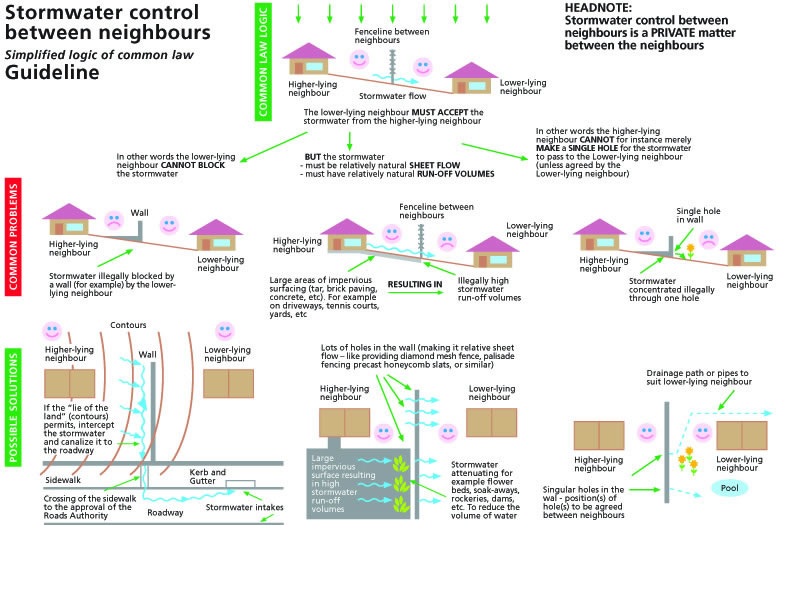In built-up urban areas, there is a need to regulate stormwater drainage in suburbs. The law sets out how neighbours should deal with stormwater run-off when it rains.
THE JOHANNESBURG STORMWATER MANAGEMENT BY-LAWS
The Johannesburg Stormwater Management By-laws provide that the quality, flow rate, velocity and frequency must be the same as the stormwater runoff, which would have flowed from the development site in its natural condition, prior to the commencement of any site development activity.
This law comes from our legal history which provided that “Natural flow” is the manner in which the water would have flowed, both as to quantity and locality from one property to another over the land, in its undisturbed state.
Accordingly in a built-up urban area, any stormwater runoff which would have flowed onto a development site naturally must be accepted onto that site and must be discharged from that site to a natural watercourse or a municipal stormwater drainage system.
By virtue of the judgement in Williams v Harris 1998 (3) SA 1970 (SCA) it was decided that a lower-lying owner is only obliged to accept a “natural flow” of stormwater from the higher-lying owner, which would have occurred before the development of the urban erf. The court held that the higher-lying owner, seeking enforcement of his right, was obliged to prove what “natural flow” was.
In the case of Pappalardo v Hau, where the Higher Lying Owner had significantly altered the natural flow of the stormwater and caused a build-up of water against the Lower Lying Owner’s Wall, the court ordered that the lower-lying owner could not be forced to install drainage pipes into his wall to drain the surplus water from the property above.

JOHANNESBURG TOWN PLANNING RECOMMENDATIONS.
The lower-lying neighbour must accept the stormwater from a higher-lying neighbour.
In other words, the lower-lying neighbour cannot block the flow of stormwater.
But the stormwater must be a relatively natural sheet flow and must have relatively natural volumes.
Accordingly, the higher-lying neighbour cannot for instance merely make a single hole in the wall for the stormwater to pass to the lower-lying neighbour, unless otherwise agreed with the lower-lying neighbour.
COMMON PROBLEMS
The lower-lying neighbour illegally blocks the stormwater run-off.
The higher-lying neighbour creates large impervious surfaces, such as brick paving and concrete driveways, which results in illegally high and unnatural stormwater run-off volume.
The higher-lying neighbour only has a single hole in the wall which illegally concentrates stormwater run-off.
POSSIBLE SOLUTIONS
If the lie of the land (contour-wise) permits; try to intercept the stormwater and canalise it to the roadway before it runs onto the lower-lying neighbour’s property.
Insert lots of holes in the wall, making it a relative sheet flow and consider providing a diamond mesh fence, palisade fencing or precast honeycomb slats or similar.
Attenuate the stormwater run-off by providing flowerbeds, soakaways, rockeries or dams to reduce the volume of water flow.
Both neighbours should try to come to an agreement about the positioning of singular holes in the wall.
The council’s policy on stormwater control is that it is a private matter between neighbours.
Be aware of approaching one’s neighbour with a request to change the landscaping of his property. It can result in indignation and a lack of cooperation; because of the age-old adage; namely “A man’s home is his castle”. People believe that they should control what happens in their own homes and that no one else should tell them what to do there.

Denoon Sampson is the Director at Denoon Sampson Ndlovu Inc, currently ranked the ‘number 1’ top performing conveyancer by First National Bank Limited. He has 30 years of experience as a conveyancer, specialising in the full spectrum of property-related law and is often called upon to give talks or contribute content on related matters.
